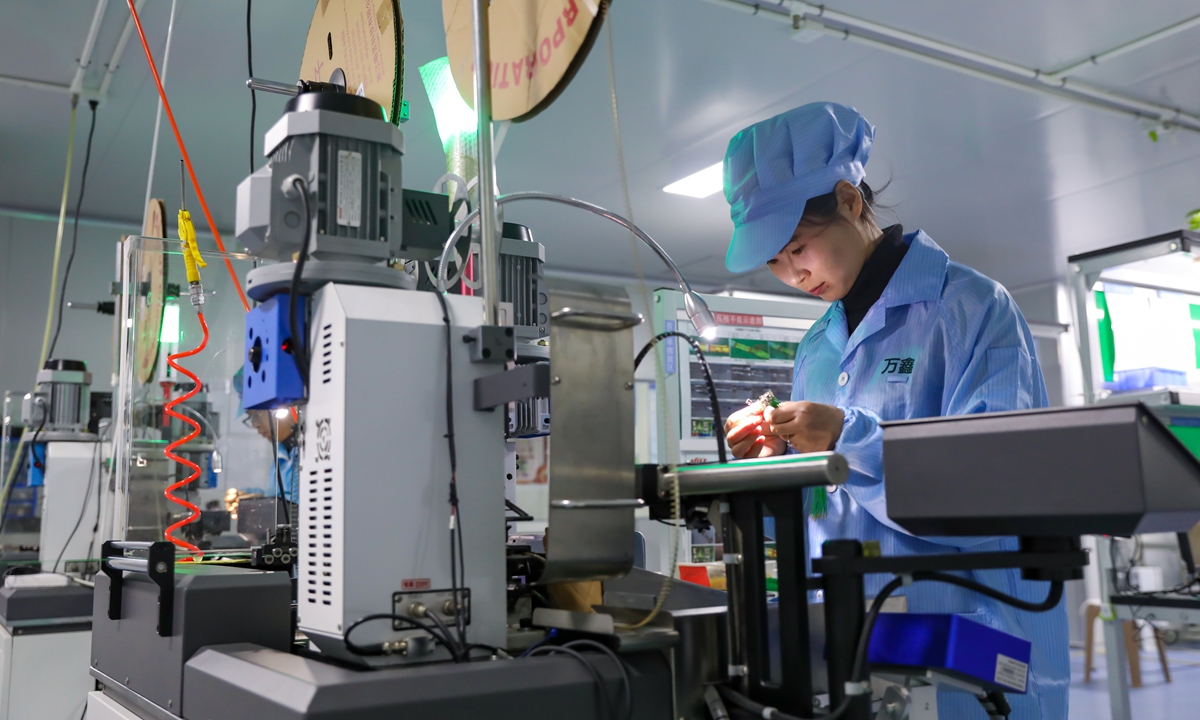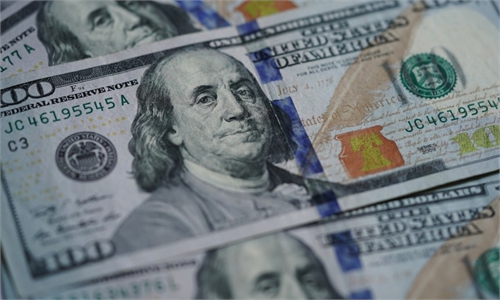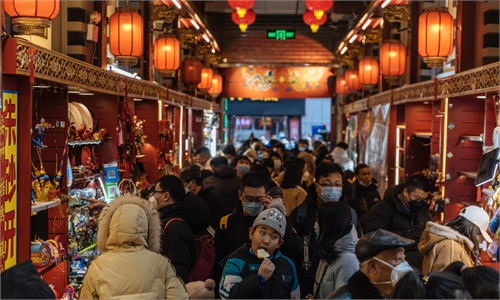With machines rolling back to production in China after Spring Festival, officials, businesses gear up for a year of full recovery

Workers produce electronic wires at a factory in Sihong County, East China's Jiangsu Province, on January 27, 2023. The factory has fully resumed production as the Spring Festival holidays draw to a close, striving for a flying start to the first quarter of the year. Photo: VCG

The busy scene at Dapukou terminal of Zhoushan Port, East China's Zhejiang Province on January 28, 2023 Photo: VCG
Amid roaring machines and celebration ceremonies, factories in China's major industrial provinces resumed production on the first working day of the Year of the Rabbit on Saturday, a symbol of a good start for the country's economy in the first year after China further optimized its COVID response by downgrading the management of the virus.Efforts have been rolled out at both government and company levels to stimulate production, such as sending chartered vehicles to transport employees and giving government incentives, as the world's second-largest economy gears up for a forceful economic recovery in early 2023 that will pave the way for a robust whole-year economic performance.
When delivering Spring Festival greetings to all Chinese at a reception in Beijing recently, Chinese President Xi Jinping said that in traditional Chinese culture, the rabbit is considered smart and agile, pure and kind, as well as peaceful and happy, expressing his hope that the people, especially the youth, can forge ahead with swift actions like rabbits, and fully display their charm and abilities in their respective sectors, the Xinhua News Agency reported on January 20.
A State Council executive meeting chaired by Chinese Premier Li Keqiang on Saturday also required sustained efforts to grasp the current economic and social development work and promote the steady rebound of economic operations at the beginning of the year.
Experts noted that officials are urging a good start in the manufacturing sector to accelerate economic growth in the first quarter, as the more powerful China's economy presents at the beginning of the new year, the more confidence investors will have in China's whole-year economy for 2023, particularly from overseas business partners.
Back to work
In the workshop of Mexin, a door company based in Southwest China's Chongqing Municipality on Saturday, robots were conducting diverse tasks as their long arms danced and weaved, while workers upgraded the company's intelligent manufacturing lines to make the production process more precise.
This is the first day the door manufacturer began work after the Spring Festival holidays. During the festival, some personnel in charge of technical equipment had already begun work to inspect the equipment on the production lines to ensure their safe operation, Wang Wangui, director of Mexin's technology center told the Global Times.
Some 1,700 kilometers away, more than 100 construction workers under the China Railway 14th Bureau Group Co were busy reinforcing formwork and erecting scaffolding on a subway construction site in Beijing.
"This year is a peak construction period for the project," project manager Zhao Long told the Global Times, referring to capacity expansion and upgrading of the Beijing Metro Line 13. According to Zhao, they are trying to finish 80 percent of the project by the end of the year.
The Global Times also learned that more than 80 infrastructure construction projects under the China Railway14th Bureau Group Co were operating non-stop during the Spring Festival holidays.
These are two pieces of the jigsaw puzzle that constitutes the broad picture of China's hustle and bustle in the manufacturing sector around the beginning of the year. In fact, machines have started to roll again or never stopped during the week-long holiday in most of China's manufacturing regions ranging from the Yangtze River Delta to southern provinces like Guangdong in the Pearl River Delta.
Some companies celebrated the resumption of work with ceremonies. On Friday, trucks carrying construction machinery set out from the industrial parks of equipment manufacturer SANY Group to head for scattered construction sites across China. The company had arranged colorful flags in the industrial parks and put red flowers on some of the trucks to celebrate the moment, SANY informed the Global Times.
MinFound Medical Systems Co, a leading CT scanner producer headquartered in East China's Hangzhou, Zhejiang Province, also resumed work on Saturday, although certain maintenance departments like production and customer service were on duty during the holiday period.
"After the Spring Festival holidays, our employees' morale was good. The
company delivered positive messages for work commencement via posters or other methods. Departments also have their own way of cheering for work," MinFound said in a statement it sent to the Global Times.
A good start
Behind the companies' passion to resume production are their efforts to complete orders and seize new ones in a year when China's economy has already shown positive signs of recovery in the wake of optimization of the COVID management measures.
And although shadows of the epidemic and challenges accumulated through the past three years have not completely waned, many companies have already sensed a pickup in market demand with orders flooding in at the beginning of this year.
"I replied to over 20 emails after the week-long holiday on the morning of the first working day, and most of the queries were sent from our clients in European countries," Lu Huazhen, representative of Zhejiang-based legging maker Zhuji Aishanglin Knitting Co, told the Global Times on Saturday.
She noted that her factory has received orders scheduled to be delivered in the autumn and winter of 2023 before the Spring Festival, and the number of orders is still rising.
Mexin also disclosed that the number of orders and production increased by 206 percent on the first day after the Spring Festival holiday, a significant rebound compared to the same period in 2022.
Some firms dispatched teams to visit overseas destinations in recent days trying to explore overseas markets and get orders.
Peter Zhang, vice general manager of MinFound, told the Global Times that he has visited seven countries and regions including the US and Brazil in about one month starting from November 16 to have face-to-face talks with overseas clients.
"The trips have proved fruitful for us, as we signed the first overseas deal for one of the company's CT products that represent the world's highest level CT technologies," he revealed.
While companies are engaged in pushing business operations at the beginning of the new year, officials from multiple manufacturing hubs in China are going all out in boosting the production resumption with stimulus policies.
For instance, Shenzhen in South China's Guangdong Province plans to invest 270 million yuan ($39.8 million) through the issuance of three major subsidies and will strengthen employment services, Shenzhen Special Zone Daily reported on Friday. Yongkang in Zhejiang has encouraged enterprises to resume normal operations by issuing subsidies for electricity usage, with up to 500,000 yuan per enterprise.
Meanwhile, officials in multiple provinces and cities have made visits to local enterprises and factories for inspection and research, aiming to further promote the resumption of work and production in the first quarter of 2023.
Yi Lianhong, secretary of the CPC Zhejiang Provincial Committee, visited key projects and enterprises on Friday, stressing the importance to ensure the operation and production of major projects and enterprises, local news outlet Zhejiang Daily reported.
In terms of securing employment, regions including Fuzhou in Fujian Province and Wuxi in Jiangsu Province have dispatched chartered trains or flights to help employees return to their posts.
The Nanning unit of China Railway in South China's Guangxi Zhuang Autonomous Region also operated special trains from Guilin, Baise and other places to transport workers back, the Global Times learned from a source.
"The aim of such efforts is to speed up economic growth in the first quarter," Tian Yun, a veteran market observer said. "A good economic performance in Q1 will definitely lift market confidence for China's whole-year GDP, while providing positive reference for the government's setting of 2023's economic target."
Data showed that China's average GDP growth over the past three years was 4.5 percent, outpacing major economies including France, Germany and the US. The growth was also faster than the world's average GDP growth from 2020-2022, which stood at 1.8 percent.
Prospects and challenges
According to Tian, market observers have earlier anticipated that China's economic recovery should take place around the second quarter, but recent signs showed that the recovery might happen in advance in the first quarter.
"China's economic recovery is faster than expected, particularly because control and development of the COVID epidemic is better than predictions at the end of last year," he told the Global Times.
Companies the Global Times talked to on Saturday expressed optimism over this year's business prospects. MinFound, for example, revealed that sales revenues climbed steadily in 2022, and they hope to take a step further in 2023 by making more breakthroughs in the high-end market.
A business manager with a Ningbo-based production and trading company surnamed Jiang told the Global Times on Saturday that the company is not worried about challenges like lingering weak global demand and increased competition.
"Last year, we exported around 700 million yuan in products, and we expect the figure could reach 1 billion this year," Jiang said, adding that they are planning a business trip to Europe in March to meet old partners, explore new ones and talk deals.
Jiang also said that company's products are more value-for-money due to the complete supply chain and technology advancement which made their business stay resilient, even during the epidemic. "Such advantages will be sustained and help us gain more weight in overseas markets after reopening," Jiang noted.
Tian Yun said that but for unexpected factors, China's industrial economy should rebound continuously in the four quarters this year, which could push this year's aggregate industrial added value to exceed last year's level.
"With such a trend, I believe that domestic industrial companies' profit levels will have a decent increase this year in general," Tian said.
However, some challenges still loom this year that pose some risks to China's industrial recovery. According to Tian, the biggest challenge might still come from reduced overseas demand amid the global economic slowdown, while shortage of raw materials in upstream sectors might also pose a problem, though to a lesser extent.


